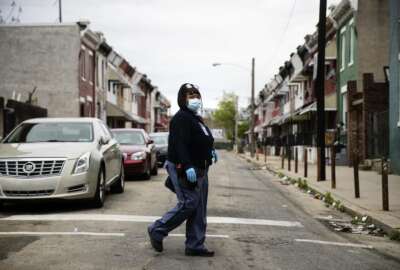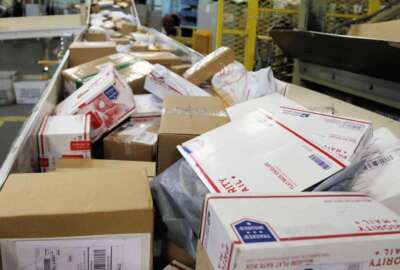
USPS sets vote-by-mail guidance for state, local election officials
With vote-by-mail services in high demand during an extended primary election season, and with demand expected to remain elevated in November, the Postal Servic...
With vote-by-mail services in high demand during an extended primary election season, and with demand expected to remain elevated in November, the Postal Service has set recommendations for state and local governments to make sure each ballot gets counted.
State and local election officials set the groundwork for vote-by-mail in their jurisdictions, but USPS General Counsel Thomas Marshall, in a letter to those officials and state party leaders, recommends allowing a week for the Postal Service to send ballots to voters, and have voters mail back ballots at least a week out from Election Day.
The agency encourages officials to send materials via first-class mail, which typically takes two-to-five days for delivery, and use Intelligent Mail barcodes to track delivery and return of ballots.
“It is critical that the Postal Service’s delivery standards be kept in mind when informing voters how to successfully participate in an election using the mail,” Marshall wrote.
The surge in demand for vote-by-mail comes at a time when USPS is also delivering 2020 census forms, keeping its own workforce healthy during the pandemic and asking Congress for financial assistance before it runs out of money less than a year from now.
Federal law requires voters to pay full postage for their mail-in ballot, a USPS spokesman told Federal News Network if a ballot has unpaid postage, “is the Postal Service’s policy not to delay the delivery of completed Absentee or Vote-By-Mail ballots.”
We are proactively working with state and local election officials on mailing requirements, including postage payment,” the spokesman said. “In cases where a ballot enters the mailstream without the proper amount of postage, the Postal Service will collect postage from the appropriate Board of Elections.
Meanwhile, USPS and the Treasury Department continue to negotiate over the terms of a $10 billion loan guaranteed under the CARES Act. USPS expects the loan would keep it from running out of cash until May 2021, but otherwise the agency has warned lawmakers that it would run out of money by September.
American Postal Workers Union President Mark Dimondstein, in a call with reporters last week hosted by the American Federation of Labor and Congress of Industrial Organizations (AFL-CIO), said that the agency’s looming financial crisis threatens its ability to operate.
“If the post office is allowed to run out of money without relief, then all postal operations become in jeopardy,” including vote by mail, Dimondstein said. “It’s one of the many things that the Postal Service has historically done well.”
While Treasury Secretary Steven Mnuchin has pointed to the Postal Service’s spike in package delivery as a sign the agency may not even need the $10 billion loan, USPS Chief Financial Officer Joe Corbett, in a video message last week, said the Postal Services doesn’t expect package revenue growth “to offset our losses in mail revenue in the medium-to-long term, during and after the pandemic.”
The Postal Service in April saw an 8% decrease in first-class mail revenue, but a 38% increase in package revenue. However, packages account for only a third of USPS revenue, and the agency lost $1.2 billion in April.
“In the near-term, the Postal Service anticipates that these trends will accelerate as the nation experiences a surge in e-commerce as a result of quarantines, shelter in place orders and travel and logistics restrictions,” Corbett said.
Corbett said that the number of employees who are infected has been coming down recently.
National Association of Letter Carriers Executive Vice President Brian Renfroe estimated more than 60 postal employees have died from the coronavirus, and more than 3,800 have tested positive or were presumed positive after exhibiting symptoms.
Nearly 25,000 postal employees, he said, have been quarantined since the pandemic began and about 2,500 of them have returned to work.
In anticipation of more quarantined postal employees returning to work, the Postal Service is testing a daily temperature check “proof of concept” in Northern Virginia and Oklahoma City for employees reporting for work and returning from quarantine.
National Postal Mail Handlers Union President Paul Hogrogian told reporters that the temperature checks are being tested to ensure the reliability of the equipment.
Read more Management news
If the proof of concept is successful, he said the postal unions will negotiate how USPS will scale up the concept to other facilities.
Dwight Burnside, a mail handler at the Merrifield, Virginia processing and distribution center said about 60% of employees at the facility have participated in the test so far.
“It’s not mandatory at this time, but it’s something that’s being looked at as a temperature screening process for going forward, to cut down on the impacts to the employees with their safety and their health,” Burnside said. “Overall, the communication, the cooperation with management has been more than expected and truly appreciated.”
Burnside said mail handlers at the facility are working at peak “holiday volume,” but only 74% of the staff are coming into work. The facility, he added, has maxed out overtime. The union’s agreement with the Postal Service allowing the agency to make temporary hires also remains in effect.
“At this time, it’s not a whole lot of people out there that are actually coming into our facility. Other facilities have been successful with hiring, but at the Merrifield facility, it’s been a test to get people in,” Burnside said.
Copyright © 2024 Federal News Network. All rights reserved. This website is not intended for users located within the European Economic Area.
Jory Heckman is a reporter at Federal News Network covering U.S. Postal Service, IRS, big data and technology issues.
Follow @jheckmanWFED





